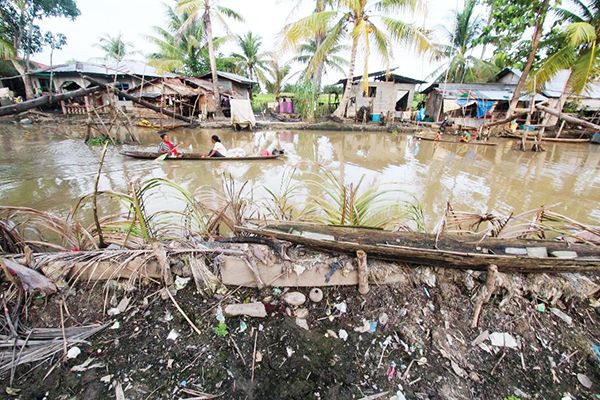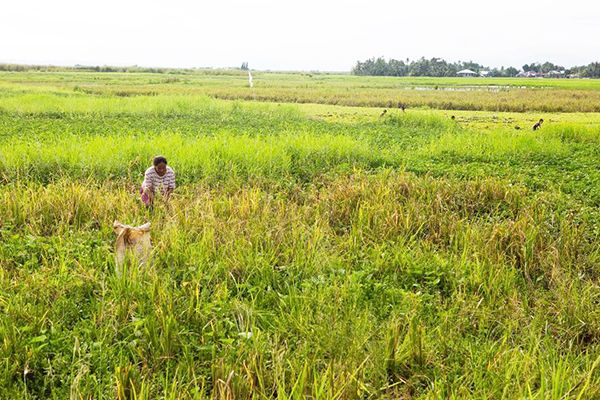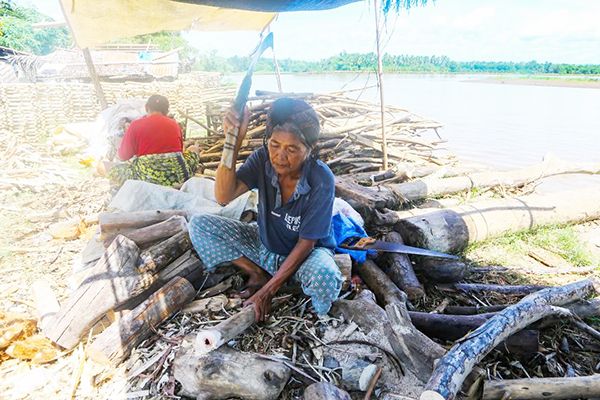Former evacuees wary of recurring climate-induced flooding than war
PAGALUNGAN, Maguindanao del Sur – Over the years, many residents of this marshy town used to be on their toes to evacuate as fighting between government forces and Moro rebels could erupt anytime.

RESIDENTS sail on the waterway in Barangay Cuyapon, Kabacan, Cotabato. (Keith Bacongco)
But today, villagers are always on the lookout not because of inevitable violence but the threat of flooding.
One of them is 60-year-old Lamin Ahad, who lives about 200 meters from the Pulangi River in Barangay Layog here.
Ahad said that they used to live on the banks of Pulangi River for more than 30 years until the land gradually scoured due to frequent swelling.
“We were forced to relocate about seven years ago across the river because every year, a big chunk of the riverbank was being scoured every time the Pulangi River swells,” the mother of six lamented in the vernacular.
Along with her dozens of neighbors, Lahad said they did not just lose their house but also their vegetable gardens which were washed away.
But even as they moved far away from the river, Ahad’s family was still unsafe from flooding as they were forced to seek refuge on safer grounds when a massive flood hit this town last July.
In a report from the Municipal Disaster Risk Reduction and Management Office, the flooding last month affected 11,523 families.
“The entire population of the town was affected by the flood. That’s the worst in the history of my hometown,” MDRRMO chief Benjamin Alip said.
While admitting that they have experienced flooding in the past, Alip recounted that it was the first time that the flooding started from the Ligawasan Marsh area. “I was surprised that a barangay official downstream reported to me that it was already flooding downstream while it was still normal in Barangay Layog, which is already beside Pulangi River.”
It turned out that the floodwaters have backflowed, he added. “There are times that it’s not raining here but some of our low-lying areas are flooded because it is raining in Bukidnon and resulted in the swelling of Pulangi River.”
The 220,000-hectare Ligawasan Marsh serves as the catch basin of the Pulangi River that flows from its headwaters in Bukidnon. Ligawasan Marsh drains to the Moro Gulf through the Rio Grande de Mindanao which cuts across several towns in Maguindanao del Sur.
Over the years, heavy siltation accumulated in the marsh and aggravated the flooding in the plains of Central Mindanao.
A report from the Bangsamoro Autonomous Region in Muslim Mindanao Rapid Emergency Action on Disaster Incidence (Bangsamoro READi) showed that the severe flooding in the region last July affected over 135,000 families or about 600,000 persons from Basilan, Lanao del Sur, Maguindanao del Norte, Maguindanao del Sur, and Special Geographic Area (SGA).
Nowhere to go
In the neighboring town of Kabacan in Cotabato province, war evacuees from different parts of Maguindanao del Sur have sought refuge in a marshy Barangay Cuyapon at the height of the conflict about 20 years ago.
While they were able to get away from bombs and bullets, displaced residents have no escape from perennial flooding.
Kitam Manudas, in her mid-40s and a mother of five, said they have fled their barangay in the neighboring town of Datu Montawal, also in Maguindanao del Sur, due to clan wars locally known as “rido.”

A WOMAN salvage rice grains from a rice field destroyed by the flooding last July in Barangay Cuyapon, Kabacan, Cotabato. (Keith Bacongco)
While admitting she is used to flooding in the marshy areas, Manudas said the recent widespread flooding was the worst she has experienced. “Many of us were not able to work in the farm or even in our backyard gardens because the floodwater was so deep and took at least three days to subside,” she lamented.
Like Manudas, 40-year-old Laga Baganian said the recent flooding hampered their economic activities. “Most of the people here work as laborers in other people’s rice farms. But since the perennial flooding destroyed most of the farms, they also lost one of their sources of income,” she said.
Manudas, who was once a war evacuee in her younger years, said they also lost a part of their rice farm to perennial flooding. She admitted that many of them are still reeling from the impact of the recent flooding.
Engr. Randy Baweg, head of the Kabacan Municipal Planning and Development Office, estimated that from 2013 to 2023, at least 2,500 hectares of rice field have been turned into a marshland due to perennial flooding.
“The river systems that drain into the Ligawasan Marsh have nowhere to go anymore. Thus, a vast area of our agricultural land is now submerged or marshy already. That’s a huge setback on our rice production,” Baweg said, adding that these areas may never be recovered by the farmers anymore.
Data from the Municipal Agriculture Office showed that there is an uptick in the affected areas due to flooding in the rice-producing town of Kabacan.
In June 2018, records showed that flooding damaged almost 600 hectares of rice farms with an estimated cost of P17.5 million. In the same month last year, damage to the rice sector jumped to at least 1,000 hectares with an estimated loss of P31 million.
Perennial flooding has resulted in at least P225 million in damage in 6,850 hectares of agricultural land from 2018 to 2023.
“This could be a part of the impact of climate change now and being aggravated by the denuded mountains and silted waterways,” Baweg said.
Rice farmer Armando Daoili of Barangay Cuyaon said that his newly transplanted rice seedlings were washed away by the flooding last July. “I spent P20,000 for the land preparation up to planting only to be washed away by the flood.”
Daoili took a gamble when he replanted rice into his one-hectare field on September 3. “We used to farm about two hectares of rice field not too far away from my rice field now. But we abandoned it in 1998 due to perennial flooding. Today, it’s already marshland.”
Romulo Tagalo, senior policy advocacy officer at Oxfam, believes that the perennial flooding will have a long-term impact on food security in the region.
“As flooding erodes basic public infrastructures such as roads, access to food and essential services are usually difficult especially in remote areas. It also results to a decline in food production among farmers,” said Tagalo.
Inevitable than war
For former war evacuees, they are still wary that another wave of flooding is more inevitable than war.
Ahad, who collects driftwood from the river and chops them into firewood for fuel, admitted that she is worried that flooding will hit them again anytime. “Unlike war, we can prepare and evacuate even before the fighting could start. But during the flood, how can you escape if all the roads are already flooded?”
Baganian admitted that flooding and war could make their lives miserable but said that flooding could recur several times in a year.
“Ang gyera ay nangyayari minsan lang sa tatlong taon o higit pa. Pero ang pagbaha, minsan lima o pitong beses nangyayari sa isang taon. Pagkatapos ng giyera, may babalikan ka pa na lupa. Pero hindi gaya ng baha, maaring mawala na ang iyong lupang sakahan.”
(War occurs once every three years or more. But flooding happens five, seven times a year. After the year, you have land to return to. But in a flood, your land might be gone forever)
The interior villages of this town and adjacent town of Kabacan and Pikit in Cotabato used to be a battleground of government forces and Moro Islamic Liberation Front (MILF) fighters.
Over the years, the cycle of violence displaced thousands of people.
The peace and order situation stabilized following the signing of the peace pact in 2014.
Anticipatory actions
To assist the flood-prone communities, Tagalo said that part of heightening risk resilience is the introduction of Anticipatory Actions (AA).
“At its core, AA is about acting ahead of any imminent disaster as indicated by science forecasts. Currently, while the government is busy preparing for the onset of a hazard such as LPA or typhoons, ordinary households are usually on a wait-and-see mode because they are not given the tools to enhance their preparedness,” he said.
The AA approach is advocating unconditional multi-purpose cash transfer two to three days before the projected physical impact of the hazard, targeting the most vulnerable populations, Tagalo said.
Desilting of waterways
Over the years, the local government units in flood-prone areas of Cotabato and Maguindanao provinces have been appealing to the national government to desilt the waterways as an immediate solution to the perennial flooding.
Alip pointed out that the river systems from the mountains to the marshy areas are now heavily silted. “We have recommended to desilt the waterways and the collected silt will be used as part of the fillings for river walls or dikes. The original depth of the rivers should be restored to help address the perennial flooding.”

LAMIN Ahad chops driftwood beside the Pulangi River in Barangay Layog, Pagalungan, Maguindanao del Sur. (Keith Bacongco)
Cotabato Gov. Emmylou Taliño-Mendoza has asked concerned government agencies to refer to the Climate-Responsive Integrated Master Plan for the Mindanao River Basin in implementing any flood mitigation projects.
The governor issued the appeal following the widespread flooding caused by heavy rains that submerged many parts of the low-lying barangays in Kabacan and Pikit and some parts of the neighboring Datu Montawal and Pagulangan in Maguindanao del Sur.
The Mindanao River Basin spreads across the provinces of Bukidnon, Davao del Norte, Lanao del Sur, Maguindanao, Sultan Kudarat, North Cotabato, South Cotabato, and some parts of Agusan del Sur and chartered cities Cotabato City and Davao City.
But for Baweg, even as the waterways would be desilted, the submerged farmlands may no longer be recovered unless the entire Ligawasan Marsh would be destilted as well.
Alip and Baweg appealed to the national government to include them in formulating plans to mitigate the flooding in the respective municipalities.
“We acknowledge the role of the experts in conducting studies to address the perennial flooding. But they should also consider our recommendations in the future because we know our own areas better,” the MDRRMO officer said.
For villagers in flood-prone areas, they are hopeful that any mitigating plans would be implemented to prevent further damage to their livelihood.
“We are hoping that the government will address the flooding because aside from its impact on our livelihood, flooding also brings diseases to the children,” Baganian said.